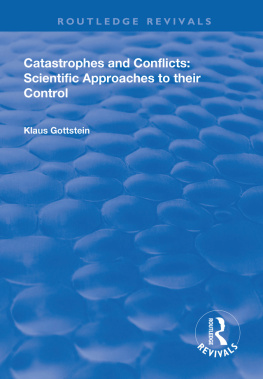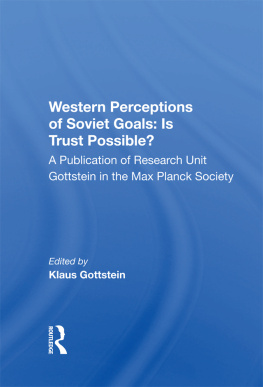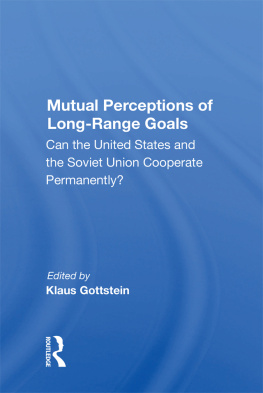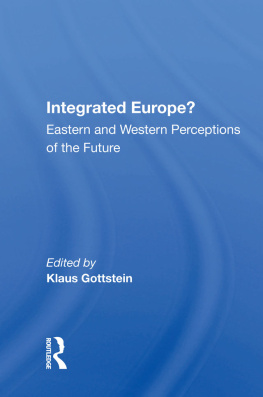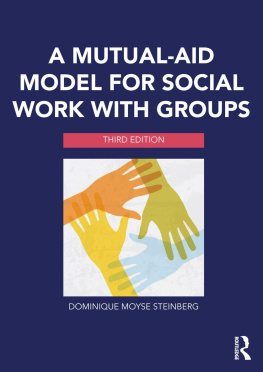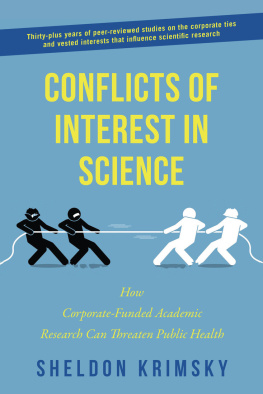First published 1999 by Ashgate Publishing
Reissued 2018 by Routledge
2 Park Square, Milton Park, Abingdon, Oxon OX14 4RN
711 Third Avenue, New York, NY 10017, USA
Routledge is an imprint of the Taylor & Francis Group, an informa business
Copyright Klaus Gottstein 1999
All rights reserved. No part of this book may be reprinted or reproduced or utilised in any form or by any electronic, mechanical, or other means, now known or hereafter invented, including photocopying and recording, or in any information storage or retrieval system, without permission in writing from the publishers.
Notice:
Product or corporate names may be trademarks or registered trademarks, and are used only for identification and explanation without intent to infringe.
Publisher's Note
The publisher has gone to great lengths to ensure the quality of this reprint but points out that some imperfections in the original copies may be apparent.
Disclaimer
The publisher has made every effort to trace copyright holders and welcomes correspondence from those they have been unable to contact.
A Library of Congress record exists under LC control number: 99072649
ISBN 13:978-1-138-31103-9 (hbk)
ISBN 13:978-0-429-45908-5 (ebk)
Understanding how to manage risk is crucial to survival and success in the modern world .... Managing risk is a necessary new science-and it is not just for the technologists
After the occurrence of great technical catastrophes-the Chernobyl reactor core melt-down, the Seveso poisoning, the Alaska coast pollution by a stranded oil tanker, the disastrous derailment of a high-speed railway train near Eschede in Lower Saxony are examples-investigations are usually started into the potential causes. Why did it happen, and how? Could it have been prevented? Frequently, human failure is identified as one of the causes. Somebody has made a mistake, somebody did not follow the rules, somebody did not inspect carefully enough the technical readiness of the equipment used.
In some cases, however, nobody is considered guilty or neglect. The disaster is said to have been caused by unforeseeable circumstances, by unpredictable events which, on the basis of the available knowledge, were completely unexpected. Nobody can be blamed, since it was unknown that the security precautions taken would turn out to be insufficient in the case under consideration.
We are all familiar with cases of both these types. They have in common that they occurred because they were connected with risks the magnitude of which had been wrongly assessed, if the risk had been seen at all. This could be due to negligence after all, or due to avoidable or unavoidable ignorance.
The analysis of unknown facts and circumstances, the search for sources of error, the estimate of limits of error within which a particular outcome may be expected to occur with a certain probability, is a task of science, as is the elaboration of proposals for the removal of sources of error and for the reduction of risks. Combatting ignorance is the task absolute of science.
Psychological aspects are of great importance in the prevention of catastrophes by human failure. As a consequence, psychology must be among the disciplines enlisted for an interdisciplinary investigation of various kinds of man-made or technology-made disasters, their origins, and their prevention.
Our time is characterized by an unprecedented progress of science and technology. The applications of scientific knowledge provide a high standard of living to a minority of the population of this earth, mostly in the Northern regions of the globe. The way of life of this minority has become the goal of development of the majority of people in the world who consider themselves underprivileged as long as the economic gap between the industrialized and the "developing countries" remains vast and is even increasing. But the lifestyle of the North, with its high consumption of non-renewable resources and its wasteful use of energy, is already causing serious damage to the natural environment. It cannot be a model for the growing world population because the balanced system of life on this planet would collapse if additional billions of people would adopt the life-style of North America or even Europe. Climate changes, destruction of the ozone layer, extinction of species of animals and plants, floods, droughts and hunger are forebodings of future catastrophes that are likely to happen unless the course of events is altered drastically. But how is this going to be accomplished? There are certainly a number of different options for the kind, and sequence, of policy changes and measures to be taken. In order to avoid unpleasant surprises, a thorough and unbiassed scientific analysis of these options will be required.
The situation is further confounded by the inherited nature of human beings. They are willing to co-operate with those whom they recognize as members of their own tribe or group. With them they are prepared to work together for common goals and joint enterprises. But they are equally inclined to fight bitterly against those whom they consider to be members of an opposing group, competitors for food, land, or work, or just suspicious "aliens" who do not share one's own beliefs, customs, habits, or values. They are declared to be enemies. Such "enemy images" are often upheld for centuries. Interestingly enough, however, peoples who have fought each other for centuries, like France and Germany, can become friends when a common enemy appears who seems to threaten all of them. Then they can be willing to join forces in order to meet the new challenge.
These characteristics were obviously essential for the survival of the human race in the course of evolution. Until very recently (on the time-scale of evolution) the number of humans on earth was very small, and so was the power of their tools and weapons. Apart from occasional fires, they could not do much damage to nature. Nature seemed overwhelming and inexhaustible. Furthermore, human beings were quite unable to endanger, by their own actions, the survival of the human race.
All this changed when, after the industrial revolution, modern technology supplied weapons of mass destruction, particularly nuclear, biological and chemical weapons, together with means of world-wide transportation and communication, at a time when the growth rate of world population had reached disquieting proportions. Finally, man had reached the ability not only to destroy the balance which nature had established in millions of years but also to commit homicide on a scale unthinkable in the past. It is highly disturbing that under these circumstances the traditional human tendency of maintaining "enemy images" and fighting against "hostile groups" continues. Under modern conditions this results in large-scale massacres, famines, and migration movements of refugees. By means of television reports, attempted relief operations, and by the arrival of masses of asylum seekers these events also destabilize world areas not directly involved in the original conflicts.
To turn around this dangerous situation for humankind, there seems to be only one hope and chance: The inhabitants of this planet will have to learn that they all belong to one group which has to keep peace and co-operate because it is threatened by a common enemy. This time the enemy is not coming from outside but from inside. It is the misuse, or the thoughtless use, of science and technology, irrespective of the undesirable by-and aftereffects of often well-intended applications of science and technology. It is also the submittance to archaic instincts against people who do not seem to share our values although these people are our co-passengers in a boat struggling to stay afloat in stormy weather and needing all hands for bailing out water.

